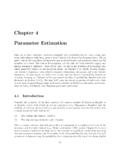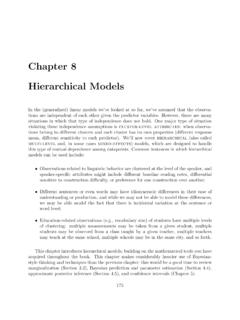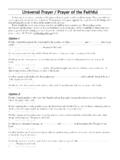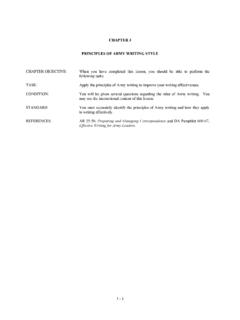Transcription of LANGUAGE AND THE LAW - UC San Diego Social Sciences
1 1 LANGUAGE AND THE LAW by Sanford Schane Table of Contents Preface Introduction Chapter 1 - Ambiguity in LANGUAGE and Misunderstanding in Law Three Law Cases of So-Called Ambiguity : Frigaliment (Lexical Ambiguity); Raffles (Referential Ambiguity); ICC: (Vagueness of Categorization) The Linguistics of Ambiguity Analysis of the Misunderstandings Frigaliment and Similar Cases: Cows or Heifers? ; Carrying a Firearm; A Lost Ring Raffles and Similar Cases: Two Streets with the Same Name; Coins in a Coin Collection; One Job Site or Multiple Sites? ICC and Similar Cases: What is a Dress?; Is Water a Mineral?; Is Gravel a Mineral? Syntactic Ambiguity and the Rule of Lenity California v. Brown and Another Case: Food-Stamp Fraud Understanding Legal Misunderstandings Chapter 2 Linguistic Metaphor and Legal Fiction Two Famous Legal Fictions: The Attractive Nuisance Doctrine and The Corporation as a Person Three Theories of Corporate Personality: Creature Theory; Group Theory; Person Theory Supreme Court Views on Corporate Personality Article III: Diversity of Citizenship: Deveaux, Letson, and Marshall Cases The Fourteenth Amendment: Rights of Foreign Corporations Metaphor in Thought and LANGUAGE The Conceptual Metaphors: LIFE IS THEATRE and A TREE IS A PERSON Analysis of the Two Legal Fictions: AN ATTRACTIVE NUISANCE IS AN INVITER and THE CORPORATION IS A PERSON Why the Law Needs Fictions and Metaphors 2 Chapter 3 - Speech Acts and Legal Hearsay What is Hearsay?
2 Legal hearsay: Verbal Act - Hearer s Reaction and Hearer s State of Mind; Speaker s Indirect State of Mind; Utterance qua Statement Made Exceptions to the Hearsay Rule: State-of-mind exceptions What are Speech Acts? Illocutions: Assertives; Commissives; Directives; Declarations; Expressives; Perlocutions; Locutions A Speech Act Analysis of Hearsay State of Mind: Indirect State of Mind; State of Mind about an Outside Event; State of Mind for Itself; State of Mind Merely Relevant: Intent The Relevance of Speech Acts to Hearsay Chapter 4 - Promise and Contract Formation Legal Promises and the Formation of Contracts: Contract as Promise or Death of Contract ? Offer and Acceptance; Consideration; Absence of Consideration The Linguistic Speech Act of Making a Promise: Searle s Felicity Conditions and their Legal Correlates A Linguistic Analysis of Consideration Felicity Conditions and The Requirements for Consideration The Sufficiency of the Consideration: Past Consideration; Preexisting Duty; Sham Consideration; Condition on a Gift; Fortuitous Occurrence Offer or Promise?
3 Alternatives to the Traditional View Conclusion Appendix: Selected Court Cases References Court Cases Cited in Text Index 3 Introduction The law is a profession of words. - David Mellinkoff 1 By means of written LANGUAGE national constitutions come into existence, laws and statutes are enacted, and contractual agreements between private individuals take effect. Spoken LANGUAGE is just as indispensable to the legal process. One need look no further than the courtroom, whether it be the interrogation of plaintiffs and defendants, the testimony of witnesses, the pleadings by attorneys, or the instructions from a judge to a jury. The legal implications of LANGUAGE continue to extend far beyond the courtroom to interactions between police and suspects, to conversations between lawyers and their clients, to law enforcement s use of surreptitious recordings, and to such unlawful speech acts as offering a bribe, or issuing a threat, or making a defamatory statement.
4 A little reflection suffices to reveal just how essential LANGUAGE is to the legal enterprise. Yet academic research on the intersection of LANGUAGE and the law is a relatively recent phenomenon, with much of the work dating from the 1980s. 2 Personal Background My own introduction to the topic began in the early years of that decade. I was leafing through some textbooks belonging to my wife, a law student back then. I could see that within those pages lay a gold mine of issues, not just concerning the law, but dealing also with the use of LANGUAGE . Perhaps it should not be so surprising that I would be fascinated by legal LANGUAGE . After all, I am a professional linguist. I was curious to know more about this area of study and interested in doing some research, but I was unsure where to turn. As yet there was no professional organization or journal devoted exclusively to the LANGUAGE and law interface, and the term forensic linguistics , which would become one of the names for what was to blossom into a vibrant discipline, had not yet been invented.
5 (There is now a professional organization, the International Association of Forensic 4 Linguists (IAFL), and a publication, International Journal of Speech, LANGUAGE , and the Law, formerly called Journal of Forensic Linguistics.) If I were serious about delving further into the subject of law and LANGUAGE , I felt I needed to know much more about the law side of the coin, and so I considered dedicating part of a forthcoming sabbatical year to legal studies. A colleague urged me to apply to the Harvard Law School for one of its Liberal Arts Fellowships. The one-year grants were intended to enable faculty from other institutions to acquire a basic law background for undertaking legal research and for creating interdisciplinary courses after returning to their home campuses. In order to accomplish these goals, the recipients, of whom I was one of four, were encouraged to pursue the first-year program, to attend other classes and seminars, and to begin a personal research project.
6 One of the lectures in a civil procedures course dealt with the concept of the corporation as a person and I decided to take on that topic as my project. It eventually burgeoned into a full-scale article that was published in a law review. In Chapter 2, the reader will find some of these ideas. Investigation into law and LANGUAGE is quite extensive, emanating not only from the field of linguistics, but also from other Social Sciences . Three principal strands of research have evolved. 3 For some researchers, the primary concern centers on LANGUAGE , and the law provides relevant data for linguistic analysis and the testing of theories about LANGUAGE . For others, the law becomes the main ingredient, and LANGUAGE serves as a vehicle for understanding the legal process and the workings of that system. For still other researchers, the major interest resides in the disciplines of psychology, sociology, or anthropology, and LANGUAGE as it operates within the legal system functions as a means for investigating psychological processes, societal interactions, or cultural traits.
7 4 Because my own academic training has been in linguistics, my approach to law and LANGUAGE tends to fall into the first category. Here are some topics directly concerned 5with the LANGUAGE of the law that have been of personal interest. I do not treat all of them in the following chapters as some have been extensively dealt with elsewhere. Legal English The mention of legal LANGUAGE tends to conjure up in the mind of the layperson legalese that often incomprehensible verbiage found in legal documents as well as an arcane jargon used among attorneys. To elucidate how this special dialect came about and how it differs from ordinary English , researchers have turned to the LANGUAGE of the law as a linguistic phenomenon in its own right, tracing its evolution and noting the peculiarities of its vocabulary and sentence structure. In fact, one of the first scholarly publications about law and LANGUAGE that I consulted was David Mellinkoff s monumental work, The LANGUAGE of the Law, published in 1963, nearly two decades before linguists would turn to legal LANGUAGE .
8 5 Mellinkoff was not a linguist; he was a law professor at the UCLA School of Law, where he taught until his death in 1999. In his book he covers the historical development of legal English, beginning with its Anglo-Saxon roots and continuing on through the Middle English period right up to the present day, while acknowledging along the way the contributions from Latin and French. He considers too some of the grammatical features of this style of LANGUAGE as well as the Social and cultural significances. Although clearly indispensable as a source for serious research into the LANGUAGE of the law, this nearly 500-page tome probably contains more information than the casual reader may need to know. A more accessible account of the history of legal English is Peter Tiersma s recent book, Legal LANGUAGE . 6 Tiersma too is a professor of law, but he also holds an advanced degree in linguistics; hence, his text appeals to both linguists and law professionals.
9 In addition to treating the historical developments, he thoroughly explains why legal LANGUAGE is so often difficult for nonlawyers to comprehend. It is full of 6wordiness, redundancy, and specialized vocabulary and it often contains lengthy, complex, and unusual sentence structure. Plain English In an endeavor to counteract the negative effects of legalese, there has developed a trend toward plain English . It began as a consumer movement to simplify the LANGUAGE of the law so that the public can understand documents that they may be required to sign, such as apartment rental leases, insurance policies, or promissory notes. The plain English movement has had a salutary effect as well within the legal process. Jurors do not always understand fully the instructions given to them by judges. To get at the root of this problem, Robert and Veda Charrow, psycholinguists, conducted several experiments. 7 They had a group of subjects, who were Maryland citizens eligible for jury duty, listen to a tape recording of jury instructions.
10 The subjects were to paraphrase what they heard to the best of their abilities. Surprisingly, almost half of the information was missing from some of the paraphrases. What exactly was causing the incomprehensibility? The difficulty was due, not so much to vocabulary items, but mostly to particular types of grammatical constructions, such as the occurrence of multiple negatives and the excessive use of passive sentences and of nominalizations. The experimenters then simplified the instructions by eliminating these complex sentence types and presented the revised versions to a second group of comparable subjects. Although the rewritten instructions did result in some improvement in the comprehension scores, it was also clear that it was highly unlikely that there would ever be complete understanding. A subsequent group of researchers then conducted some experiments to determine what exactly ought to constitute an acceptable level of comprehension.














